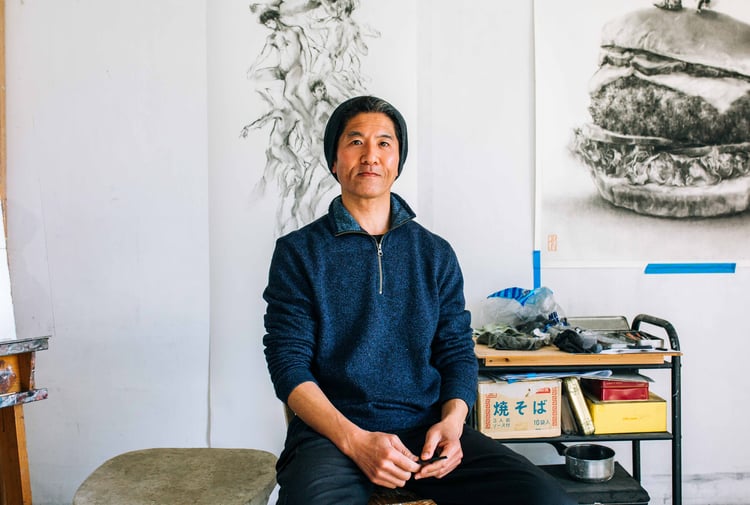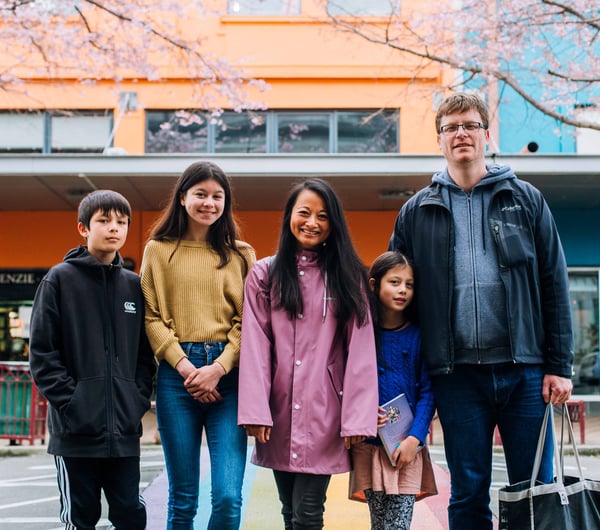Charcoal Maker and Master

Naga Tsutsumi
Naga Tsutsumi is one of Palmerston North’s most cherished artists. His large scale charcoal drawings are considered and full of movement and detail to explore.
Naga Tsutsumi is one of Palmerston North’s most cherished artists. His large scale charcoal drawings are considered and full of movement and detail to explore. Originally from Japan, Naga works out of his home studio, but his art can be seen at Zimmerman Art Gallery and he also holds workshops at Square Edge. We caught up with Naga at home to learn more about his journey as an artist and his process. He even, as it turns out, makes his own charcoal.
How do you make your own charcoal?
Basically I use either a trunk or branches, peel the bark away and let it dry for a few weeks. I need to get it completely dry before it’s ready to fire in a temperature controlled kiln. People think ‘Oh, it’s easy to make charcoal’ but that is for grilling. If you want durable charcoal for drawing, you have to control every step of the process, especially the rate of temperature rise - the slower the better.
You must go through a lot of charcoal?
That’s the thing. This piece here I bought. I paid 25 bucks to get about 25 sticks, and since I work on a big scale, I use a lot. We know that charcoal is just burned branches, so i thought why can’t I make some? Not many artists make it themselves.
How did you get the process down?
I just started testing it out with my friend who is a ceramicist. He picked up many different kinds of branches like cherry, apple, oak, rimu, willow and totara. We knew that willow works well, but I felt something different working with rimu and totara because they are New Zealand natives. Rimu is just too hard to draw with, but we found totara works very well. To me, it makes the perfect charcoal. It’s not too hard, too soft or too greasy. We fire it gradually going from 200 to 600 degrees in about five hours. The charcoal reminds me of Asian culture as well - Chinese paintings and Sumi-e ink wash from Japan. Being able to make charcoal with totara, is a nice harmony between my Japanese background and New Zealand - I feel very happy with it.
Did you always want to become an artist?
No, I was born in Tokyo - my family are not really art people. My dad worked for a car manufacturer and was always busy. I thought, is this my future? I’m not really a conformist and in my school days I felt different. I wasn’t very good at science but I did go to university in Japan. I didn’t go to class though, and instead I worked for a record store during the day. I was questioning my life, asking if what I was doing was meaningful and that was in the late 80s. At that time you could get any interesting job you wanted in Japan if you spoke English. So I decided to go to the U.S. to learn English. My parents were happy to send me off as it was supposed to be just for one-year of English study. I left for Oregon in ’89.
Is that where you started thinking about becoming an artist?
Well I did pass the English exam there, but I was afraid to speak the language so I took classes that I didn’t have to speak much in. That was art and drawing. I remembered how I had loved to draw as a kid but no one recognised my drawings. In this class, my teachers were very impressed. One said, don’t go back to Japan, study art here. So I did. I convinced my parents I’d be able to get a teaching job afterwards. I then got my masters of fine arts, I felt like my art life had just started, but the job didn’t come so I went back to Japan. I cried, of course, but I went.
How did you make your way from Japan to New Zealand?
Once I got back to Japan, I started life like my father did. I wore a suit and took a packed train to work everyday. I worked at an art supply company and my boss said I must forget about making art and do my job. I liked him and he made really great paint brushes, but I thought, can I really give this up? I thought of nothing else but leaving. Soon I found a job in New Zealand for Japanese people with a masters degree in teaching. I didn’t have that but I had taught art a bit when I was in the U.S. I applied and got the job, that was in 2003.
What do you like about living here?
The people, and nature reminds me of both Oregon and the countryside of Japan. I find that there is a very deep culture of art here and people like to have artworks that enhance their life. In Japan having art in your home is just for the rich. I really appreciate the people who see something valuable in my work. It’s wonderful to know my work finds a new place and pleases someone else's eyes and minds. I am so blessed to be a part of the art community in New Zealand.

